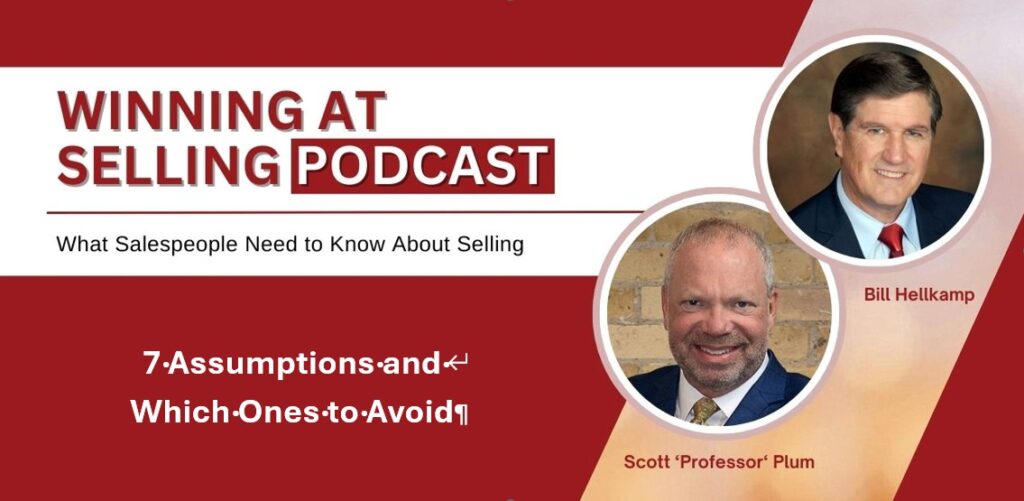 Our perception of a situation is shaped by past experiences, judgments, beliefs, and biases. These elements mix together, each weighted differently, to form our unique perspective. No two people see reality the same way. But is our perception of reality true? It’s real—yes. No one can take away your reality. However, what’s real may not always be true. This is a critical question to consider as we encounter new situations.
Our perception of a situation is shaped by past experiences, judgments, beliefs, and biases. These elements mix together, each weighted differently, to form our unique perspective. No two people see reality the same way. But is our perception of reality true? It’s real—yes. No one can take away your reality. However, what’s real may not always be true. This is a critical question to consider as we encounter new situations.
1) “Prospects will only buy from me if I have the lowest price.”
If a prospect is solely focused on price and not purchasing a commodity, they’re likely not engaging with a salesperson—they’re buying online. Salespeople add value to the purchasing process, yet this is often forgotten when negotiating price.
Prospects may claim to be price-driven, but this is often a defense mechanism. Their skepticism and misconceptions prevent them from seeing the real differentiators that could benefit them.
✅ Ask:
- “Besides price, what other factors are important in your decision-making process?”
-
“What would happen if you chose the lowest-priced option and it didn’t deliver the expected results?”
Your role is to help them define value—their value, not yours.
2) “I must be ‘liked’ by my prospect before they buy from me.”
Prospects like many salespeople. And they often take free advice from them without making a purchase (showrooming). But when it comes to making a change and taking a risk, they choose the salesperson they respect the most.
Respect is earned by keeping the focus on them—asking insightful questions, practicing active listening, and guiding the conversation.
✅ Ask:
- “What qualities do you look for in a business partner when making an important decision?”
- “Beyond liking someone, what makes you feel confident in choosing them to help with your needs?”
Move past being liked. Strive to earn their respect.
3) “They know what they want.”
Often, the problem a prospect presents is not the real problem. When they search for a solution on their own, they arrive at a perceived solution to a perceived problem. If you simply build on that misdiagnosis, you’re committing sales malpractice.
Your job is to align the right solution with the real problem and their goals. Mismatched solutions lead to dissatisfaction, profit loss, and damage to your reputation.
Prospects love to share stories—bad ones more than good ones.
✅ Ask:
- “How did you determine that this is the best solution for your needs?”
- “What challenges do you anticipate even if you move forward with this solution?”
4) “I know what they want.”
If you approach a prospect with a predetermined solution, regardless of fit, you’ll face resistance. And if the sale does close, you may hear: “Why doesn’t it do that?”
People buy for their reasons, not yours. Your role is to uncover those reasons and match the right solution to the right problem.
✅ Ask:
- “What’s most important to you in a solution—performance, ease of use, long-term cost savings, or something else?”
- “What concerns do you have that haven’t been addressed yet?”
5) “I can help them.”
Taking this stance places more commitment on you than on the buyer. But in order for them to buy, they must first accept that they need to change.
Change is difficult. It’s driven by emotion—desire or frustration—and later justified intellectually. You may see the solution, but if they don’t see the problem, they won’t buy.
✅ Ask:
- “What’s preventing you from making a change right now?”
- “If nothing changes, how will that impact you or your business in the next 6-12 months?”
6) “They want my help.”
Even if you prove the prospect has a problem and get them to admit it, that doesn’t mean they want your help. They may have someone else in mind due to loyalty, or they may feel vulnerable and uncomfortable working with you.
There are two commitments in the buying decision:
- Do I want to fix this?
- Do I want you to fix it for me?
You need both to close the sale.
✅ Ask:
- “If you were to move forward with someone, what qualities would they need to have?”
- “What’s the biggest factor in deciding who you’ll work with to solve this issue?”
7) “They don’t have the money.”
Money is tied to price. Cost, however, is tied to consequences and risk. If the cost of doing nothing is greater than the price of change, they will find the money.
Cost – Price = Value
If they say they don’t have the money, it means you haven’t demonstrated enough value. People buy when they see enough value—help them recognize the cost of not making a change.
✅ Ask:
- “What would happen if you delayed this decision for another six months?”
- “Have you considered the long-term costs of maintaining the status quo versus making a change?”
Shift Your Approach
Want to feel more confident in appointments, cold calls, or networking events? Adopt this mindset:
“I don’t want to assume you have a problem or that you need my help.”
This removes pressure from both you and the prospect, allowing for an open conversation. When approached this way, the real buying motives—defined by the prospect, not assumptions—will emerge.
Please subscribe and share the podcast with your colleagues and on your social media.
Go out and get better, 1 skill at a time. Joyful Selling!
| Bill Hellkamp, Co-Host 612-247-1455 [email protected] |
Scott Plum, Co-Host 612-789-5700 [email protected] |
For a printable download – CLICK HERE: 7 Assumptions and Which Ones to Avoid
Podcast Form / Offer Interest Form







Speak Your Mind